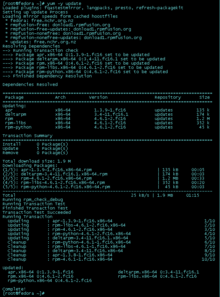
Back يلو دوج أبداتر (موديفايد) Arabic Yum Bulgarian Yum Czech Yellowdog Updater, Modified German Yum (software) Spanish یام (نرمافزار) Persian Yum Finnish Yellowdog Updater, Modified French YUM HE Yum ID
 YUM running an update on Fedora 16 | |
| Developer(s) | Seth Vidal |
|---|---|
| Initial release | June 2002[1] [2] |
| Stable release | 3.4.3
/ 28 June 2011 |
| Repository | |
| Written in | Python[3] |
| Operating system | Linux, AIX, IBM i, ArcaOS |
| Platform | RPM |
| Type | Package management system |
| License | GPLv2 |
| Website | yum |
The Yellowdog Updater Modified (YUM) is a free and open-source command-line package-management utility for computers running the Linux operating system using the RPM Package Manager.[4] Though YUM has a command-line interface, several other tools provide graphical user interfaces to YUM functionality.
YUM allows for automatic updates and package and dependency management on RPM-based distributions.[5] Like the Advanced Package Tool (APT) from Debian, YUM works with software repositories (collections of packages), which can be accessed locally[6] or over a network connection.
Under the hood, YUM depends on RPM, which is a packaging standard for digital distribution of software, which automatically uses hashes and digital signatures to verify the authorship and integrity of said software; unlike some app stores, which serve a similar function, neither YUM nor RPM provide built-in support for proprietary restrictions on copying of packages by end-users. YUM is implemented as libraries in the Python programming language, with a small set of programs that provide a command-line interface.[7] GUI-based wrappers such as YUM Extender (yumex) also exist,[8] and has been adopted for Fedora Linux until version 22.[9]
A rewrite of YUM named DNF replaced YUM as the default package manager in Fedora 22[9] (in 2015). This was required due to Fedora's transition from Python 2 to Python 3, which isn't supported by YUM.[10] DNF also improves on YUM in several ways - improved performance, better resolution of dependency conflicts, and easier integration with other software applications.[11] From RHEL 8, yum is an alias for DNF.[12]
- ^ "Initial Commit". source control message. Seth Vidal. 7 June 2002. Retrieved 17 September 2021.
- ^ "Oldest Mailing List Message". yum mailing list archive. Grigory Bakunov. 11 June 2002. Retrieved 17 September 2021.
- ^ Jang, Michael H. (14 December 2005). "Chapter 7 – Setting Up a YUM Repository". Linux Patch Management: Keeping Linux Systems Up to Date (PDF). Prentice Hall Professional.
- ^ Brown, Robert G. "YUM (Yellowdog Updater, Modified) HOWTO - Introduction". Duke Physics. Retrieved 12 July 2013.
- ^ Shields, Ian (11 May 2010). "RPM and YUM package management". Learn Linux, 101. IBM. Retrieved 12 July 2013.
- ^ "Creating a Local YUM Repository Using an ISO Image". Oracle. Retrieved 12 July 2013.
- ^ Cite error: The named reference
Brownwas invoked but never defined (see the help page). - ^ Cite error: The named reference
yumexwas invoked but never defined (see the help page). - ^ a b Miller, Matthew (11 June 2014). "Board Meeting, Rawhide Rebuilt, Firewall Debate, ARM 64, and DNF as Yum Replacement (5tFTW 2014-06-10)". Fedora Magazine. Retrieved 4 May 2016.
- ^ Wallen, Jack (2015-07-02). "What You Need to Know About Fedora's Switch From Yum to DNF". Linux.com. Retrieved 2021-09-26.
- ^ Edge, Jake (2014-01-15). "DNF and Yum in Fedora". LWN.net. Retrieved 2018-10-16.
- ^ Matteson, Scott (2019-03-30). "What's new with Red Hat Enterprise Linux 8 and Red Hat Virtualization". TechRepublic. Retrieved 2019-09-24.